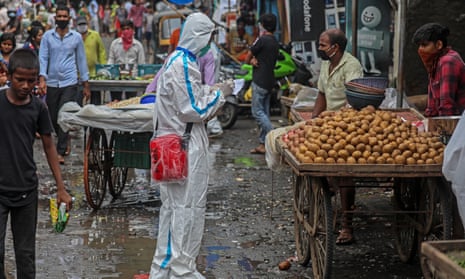India has overtaken Russia to claim the third highest number of coronavirus cases in the world after recording almost 25,000 new infections a day, mainly clustered in the megacities of Mumbai, Delhi and Chennai.
The total number of cases of Covid-19 in India rose to 697,413 on Monday, after three consecutive days of record-breaking infection increases. Only Brazil, with 1.6 million, and the US, with 2.88 million, have more cases and experts say that the country is still months away from reaching its peak.
The death rate in the country of 1.3 billion people continues to remain relatively low, with 19,693 fatalities, ranking it eighth in the world and at 2.8% it is lower than the global average of 4.7%.
“With the spurt of cases that has happened in the last week, we are definitely entering a worrisome phase of the epidemic,” said Dr Preeti Kumar, a vice-president at the Public Health Foundation of India.
“In India this is a concentrated epidemic, it is very urban centric. While rural areas seem to have it more under control, the way the virus has been spiking in our densely populated big cities indicates the epidemic will continue here for some time.”
The megacities of Mumbai, Delhi and Chennai collectively account for about two thirds of India’s cases.
In Delhi, which hit 100,000 cases on Monday, the city’s chief minister, Arvind Kejriwal, said there was “no need to panic”. He said the number of ICU beds available in the capital had increased by 169%. A sprawling new medical facility in Delhi the size of 20 football pitches, built in a spiritual centre, opened its doors this week with capacity for 10,000 mildly symptomatic and asymptomatic patients.
A study by the Indian Council of Medical Research has predicted India would not hit its peak until mid-November. However Dr Randeep Guleria, director of the All India Institute of Medical Science, was more optimistic about Delhi’s prospects. “If the number of cases in Delhi continues to be static or decreases over the next few weeks, and the decline is at a sustained pace, then we can say that we may pass the peak in August,” he said.
Yet even with new facilities being built, a lack of doctors and healthcare workers is proving problematic across the country, as so many are getting infected on the frontline or are increasingly reluctant to risk exposure.
Last week, the testing of Covid-19 samples in three top health institutes in Patna, the capital of Bihar state, had to be closed for three days after 15 doctors, lab technicians and other health workers tested positive for the virus. The labs in Patna medical college and hospital, Rajendra Memorial Institute of Medical Sciences and All India Institute of Medical Sciences were all shut for fumigation.
Dr Taha Mateen, managing director of HBS hospital in Bangalore, said in a video, that went viral over the weekend, that it had “been a virtual bloodbath” in the ward, with only him and one other doctor willing to work on coronavirus cases.
“I have beds, I have oxygen beds, I have ventilators, I have all the equipment. I have another 30 beds like this but I don’t have doctors working here,” said Mateen, pleading for other doctors to offer their services.
India began to loosen its stringent coronavirus lockdown in early June, allowing for domestic travel and for shops and restaurants to open. However, in states such as Bihar, which saw the return of millions of migrant workers, there was a 25-fold increase in Covid-19 cases. As more than 3 million migrant workers returned this month, cases in Bihar went from 485 to 12,140.
The southern state of Kerala, which had been globally celebrated for its successes in containing the virus, also appeared to be experiencing a new rise in cases, with 193 reported on Monday. The Kerala government ordered a triple lockdown in the state’s biggest city of Thiruvananthapuram following a new state law which made face masks and social distancing mandatory in public spaces for one year till at least 2021.
Plans to reopen India’s most revered and visited monument, the Taj Mahal, in the city of Agra, were also put on hold indefinitely. Agra, one of India’s first big clusters of the virus, remains the worst-affected city in Uttar Pradesh, the country’s most populous state.
Yet, amid the tragedy, there were small glimmers of hope. In Delhi, a 106-year-old man, who had survived the Spanish flu epidemic when he was four, was this week discharged from Rajiv Gandhi Super Speciality hospital after making a full recovery from coronavirus. “He not only recovered from Covid-19, he recovered faster than his son, who is also very old,” a senior doctor told local media.
Manoj Chaurasia contributed reporting from Patna
